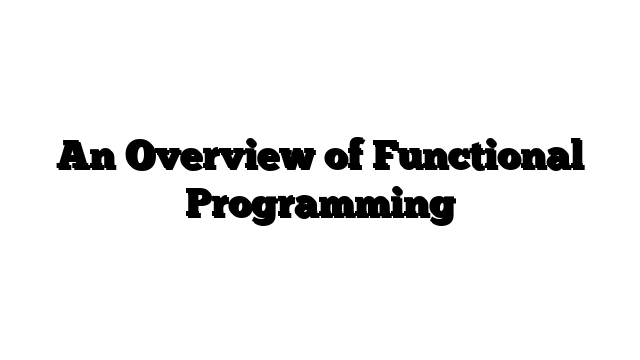Functional programming in software development is garnering popularity among programmers. In contrast to traditional imperative programming, which emphasizes how to accomplish a task through a series of stages, FP emphasizes what should be accomplished by applying mathematical functions to data.
In this article, we will examine functional programming, its fundamental concepts and principles, and the benefits it offers to developers and businesses.
Fundamentals of Functional Programming
Procedural programming, object-oriented programming, and functional programming are the three types of programming. We’ll look at the last one in detail.
Object-oriented programming (OOP) involves the development of data and action structures known as “objects” (hence the name). Everything in functional programming is a function. Whereas functional programming attempts to keep data and behavior distinct, object-oriented programming unifies the two.
Functional programming is, at its essence, a programming paradigm that approaches computation as the evaluation of mathematical functions and avoids state changes and mutable data. It is governed by a set of fundamental principles that govern the writing and execution of code.
- Pure Functions: Functional programming is built on pure functions. They always produce the same output for the same input and have no additional effects, which means that they do not alter external states or variables. Pure functions provide code with predictability and transparency. They are deterministic, which makes it simpler to reason their behavior and effectively test them.
- Immutability: Once data is created, immutability indicates that it cannot be altered. Instead, transformations are used to generate new data. Immutability guarantees data consistency and aids in preventing errors caused by unintended data modifications. It promotes a programming approach in which data travels through a series of transformations.
- First-Class and Higher-Order Functions: In functional programming, functions are regarded as first-class citizens, meaning they can be assigned to variables, passed to other functions as parameters, and returned as values. Functions that operate on other functions constitute higher-order functions. First-class and higher-order functions allow for the composition of functions, enabling the creation of complex behavior by combining basic, reusable functions.
- Referential Transparency: An expression is transparent if its value can be substituted for it without altering the behavior of the program. Pure functions exhibit transparent referentiality. Transparency enables equational reasoning, which simplifies code comprehension and optimization. It is a crucial characteristic that promotes code integrity.
- Lazy Evaluation: Expressions are not evaluated until their results are actually required; this is known as lazy evaluation. Lazy evaluation can result in a more efficient use of resources because only required computations are conducted. It is especially beneficial when working with potentially infinite data structures.
These fundamental concepts are the foundation of functional programming. You can write code that is more predictable, testable, and maintainable if you embrace pure functions, immutability, and functional composition. Functional programming is not just a coding technique; it is a problem-solving paradigm that encourages a new perspective.
The Benefits of Functional Programming
Functional programming provides several benefits that make it an appealing option for developers and organizations:
- Code Clarity: Functional programming promotes a declarative and concise coding style, making code more straightforward to read, maintain, and comprehend.
- Concurrency and Parallelism: The focus of functional programming on immutability and pure functions simplifies concurrent and parallel processing and reduces the risk of race conditions.
- Testability: When code has just functioned and has no side effects, it becomes highly testable, resulting in more dependable software.
- Reusability: Functional components are readily re-usable across various portions of an application, thereby promoting code modularity.
- Scalability: FP can manage complex problems and large datasets with efficiency.
- Error Handling Improvements: Monads and algebraic data structures are frequently used in functional programming for error-handling enhancements.
Languages for Functional Program Development
Multiple programming languages offer varying degrees of support for functional programming. Haskell, Lisp, Clojure, Scala, and JavaScript (with libraries such as React and Redux) are prominent FP languages.
Haskell
Prominence: Haskell is well-known for its functional programming purity. It has influenced the development of other languages and serves as a benchmark for functional languages.
Use Cases: Haskell excels in domains that require rigorous correctness, including compilers, theorem proving, and mathematical modeling. It is also increasingly used in web development and finance.
Lisp (Common Lisp, Clojure)
Prominence: Lisp, in its numerous dialects such as Common Lisp and Clojure, has a lengthy history in the world of programming. Common Lisp is renowned for its adaptability, whereas Clojure has gained popularity in functional programming.
Use Cases: Common Lisp has been used in artificial intelligence, symbolic mathematics, and data analysis. Popular uses of Clojure include web development, concurrency, and data-driven applications.
Scala
Prominence: Scala has garnered widespread recognition as a hybrid programming language that integrates object-oriented and functional paradigms. It is prominent within the Java ecosystem.
Use Cases: Scala is a popular option for developing concurrent and scalable applications, making it a suitable choice for web services, data processing, and distributed systems.
JavaScript
Prominence: JavaScript was originally an imperative language, but tools like React and Redux have made it more like functional programming. These libraries are now fundamental to contemporary web development.
Use Cases: Front-end web development is dominated by JavaScript, particularly in tandem with React and Redux. It enables dynamic and interactive user interfaces, making it essential for web applications.
Not only have these languages and libraries shaped the landscape of functional programming, but they have also influenced the programming community as a whole by introducing functional concepts to programmers in a variety of domains.
Conclusion
Functional programming is not merely a fleeting trend; it represents a fundamental transformation in the way problems are approached. Its emphasis on pure functions, immutability, and declarative coding style promotes robust, dependable, and maintainable code. As you investigate the world of software development, incorporating functional programming into your arsenal can expand your horizons and enable you to write more eloquent and efficient code. Whether you are a seasoned developer or just beginning your coding voyage, knowing the fundamentals of FP can be valuable to your skill set.
James Martin is a passionate writer and the founder of OnTimeMagazines & EastLifePro. He loves to write principally about technology trends. He loves to share his opinion on what’s happening in tech around the world.


